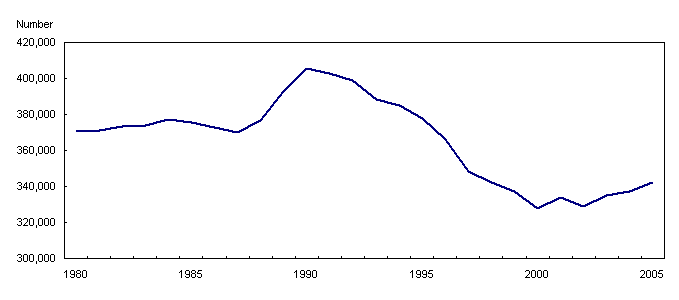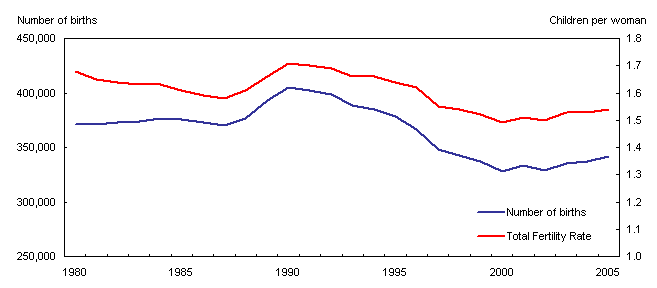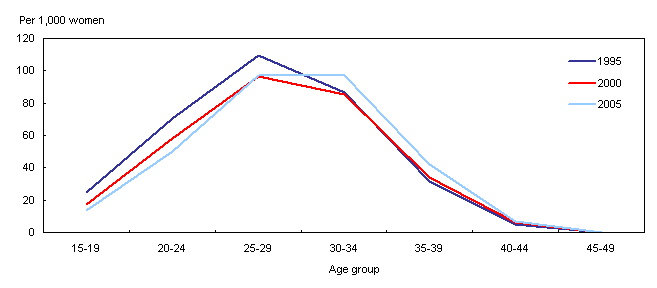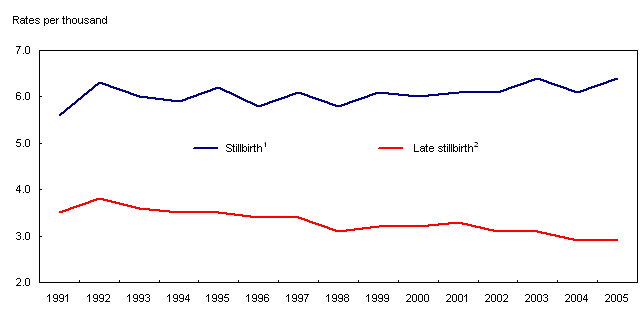Common menu bar links
2005
Archived Content
Information identified as archived is provided for reference, research or recordkeeping purposes. It is not subject to the Government of Canada Web Standards and has not been altered or updated since it was archived. Please "contact us" to request a format other than those available.
Analysis
A. Number of births
In 2005, a total of 342,176 births were registered in Canada, 5,104 (1.5%) more than in 2004, and the highest annual number since 1998 (342,418).
A.1. Trends in births
From 1980 to 1988, annual births hovered around 370,000 (Chart 1). A sharp rise of nearly 10% over the next three years brought the 1990 total to 406,000. However, a steady decline through the 1990s resulted in approximately 328,000 births in 2000, the lowest number since the end of World War II. Since 2000, there has been an upturn, bringing the 2005 total to just over 342,000 births.

A.2. Geographic differences
Between 2004 and 2005, changes in the annual number of births varied by province and territory.
Six provinces and one territory recorded more births in 2005 than in 2004: Newfoundland and Labrador, Quebec, Ontario, Manitoba, Alberta, British Columbia and Northwest Territories. Alberta and Quebec led with increases of 3.3% and 3.1%, respectively. These two provinces accounted for almost three-quarters (71%) of the total increase of births in Canada between 2004 and 2005.
The other provinces and territories saw a decline in the number of births from 2004 to 2005.
| Place of residence of mother | 2004 | 2005 | 2004 to 2005 change | |
|---|---|---|---|---|
| number | percent | |||
| Canada | 337,072 | 342,176 | 5,104 | 1.5 |
| Newfoundland and Labrador | 4,488 | 4,501 | 13 | 0.3 |
| Prince Edward Island | 1,390 | 1,340 | -50 | -3.6 |
| Nova Scotia | 8,734 | 8,557 | -177 | -2.0 |
| New Brunswick | 6,959 | 6,892 | -67 | -1.0 |
| Quebec | 74,072 | 76,346 | 2,274 | 3.1 |
| Ontario | 132,551 | 133,760 | 1,209 | 0.9 |
| Manitoba | 13,811 | 14,145 | 334 | 2.4 |
| Saskatchewan | 11,983 | 11,967 | -16 | -0.1 |
| Alberta | 40,779 | 42,110 | 1,331 | 3.3 |
| British Columbia | 40,489 | 40,827 | 338 | 0.8 |
| Yukon | 365 | 320 | -45 | -12.3 |
| Northwest Territories | 698 | 712 | 14 | 2.0 |
| Nunavut | 747 | 699 | -48 | -6.4 |
B. Fertility
The total fertility rate (TFR) estimates the average number of children a woman can be expected to have in her lifetime, based on the age-specific fertility rates of a given year.
B.1. Trends in fertility
Canada’s fertility rate has generally risen since 2001 (Chart 2). In 2005, the TFR was 1.54 children per woman, up from 1.53 the previous year, and the highest rate since 1998 (1.54).

The TFR and the annual number of births declined throughout the 1990s. However, since 2001, the TFR has trended upward.
The drop in the TFR (and consequently, in the number of births) in 2000, and the quick recovery in 2001, may have been related to a desire to have a baby in the first year of the new millennium. The number of marriages spiked in 2000. 1
B.2. Age of mother and age-specific fertility rates
The average age of women giving birth rose steadily in the last 25 years, from 26.0 in 1980 to 29.2 in both 2004 and 2005.
Over the last 15 years, and particularly in the last five, there has been a shift in the age groups with the highest fertility rates (Chart 3).
In 1995 and 2000, age-specific fertility rates peaked among 25 to 29-year-olds. However, in 2005, women aged 25 to 29 and 30 to 34 shared the highest rates.

B.3. Analyzing 2005 fertility rate
Two factors could account for the increases in the number of births in recent years: an increase in the number of women of reproductive age and/or a rise in fertility rates.
By applying age-specific fertility rates for 2004 to the female population in 2005 (Table 2), it is possible to estimate how much of the increase in births in 2005 can be attributed to changes in population size versus changes in fertility.
| Age Group | 2004 ASFR 1 | 2005 female population | Expected births 2 | 2005 ASFR 1 | Difference 3 |
|---|---|---|---|---|---|
| 15-19 | 13.7 | 1,047,142 | 14,334 | 13.4 | -0.3 |
| 20-24 | 51.0 | 1,096,952 | 55,897 | 50.4 | -0.5 |
| 25-29 | 97.4 | 1,085,408 | 105,710 | 97.3 | -0.1 |
| 30-34 | 95.8 | 1,103,489 | 105,744 | 97.4 | 1.6 |
| 35-39 | 40.1 | 1,176,658 | 47,203 | 42.1 | 2.0 |
| 40-44 | 6.9 | 1,366,287 | 9,369 | 7.1 | 0.3 |
| 45-59 | 0.3 | 1,312,868 | 420 | 0.3 | 0.0 |
| Total | 338,677 |
Had there been no change in age-specific fertility rates between 2004 and 2005, the number of births in 2005 would have been 338,677 (Table 2), an increase of 1,605 births over 2004. However, the total increase between 2004 and 2005 was 5,104 births. The additional 3,499 births can, therefore, be attributed to changes in fertility.
The age-specific fertility rate of women aged 30 to 44 rose in 2005, counterbalancing declining rates among women aged 15 to 29. The upturn was most pronounced among women aged 30 to 39. Therefore, the increase in the number of births is largely attributable to the rising fertility of women in their thirties.
C. Echoes of the baby boom
The period between the end of World War II and the mid-1960s witnessed a dramatic increase in the fertility rates of women of childbearing age, the result of which was the baby boom.
C.1. Historical trends
In 1947, the TFR was 3.6 children per woman, the highest level since 1921. 2 The number of births in 1947 totaled 372,600, and the crude birth rate was 28.9 per 1,000 population (Chart 4).
At the height of baby boom in 1959, annual births exceeded 479,000, the highest number recorded since comparable Canada-wide vital statistics were first compiled in 1921.
The annual number of births remained high for a few more years, and then dropped sharply starting in 1964. This period of relatively low births, known as baby bust, lasted for approximately ten years until the mid-1970s.

C.2. Echo
The first baby boom “echo” was expected in the mid-1970s, approximately 25 years after the beginning of the baby boom.
But while there was a sizeable increase in the number of births in 1974 and 1975, gains in the following years were relatively modest. Only in the late 1980s (1988 to 1990) was there a substantial rise in the number of births (Chart 4).
Between 1988 and 1995, Canada experienced a clear baby boom echo as the baby boomers had a large number of births, peaking at 405,486 in 1990.
Thereafter, annual births dropped, falling to 327,882 in 2000, which was less than the lowest number in the baby bust period.
Over the past five years, Canada has seen an upward trend in the number of births, with the mean age of mothers at 29 years.
C.3. Comparison with other low-birth-rate countries
The rising number of births in Canada parallels trends in several other low-birth-rate countries, which have also experienced an upturn in fertility in recent years (Table 2).
In some countries, this upward trend began before 2003: the Czech Republic (2000), Sweden (2000), Spain (1999), and France (1998).
| Country | 2003 | 2004 | 2005 |
|---|---|---|---|
| Czech Republic | 1.18 | 1.23 | 1.28 |
| Greece | 1.29 | 1.30 | 1.33 |
| Spain | 1.31 | 1.33 | 1.35 |
| Canada | 1.53 | 1.53 | 1.54 |
| Belgium | 1.64 | 1.68 | 1.72 |
| Sweden | 1.72 | 1.76 | 1.77 |
| United Kingdom | 1.73 | 1.78 | 1.80 |
| Denmark | 1.76 | 1.78 | 1.80 |
| Australia | 1.75 | 1.77 | 1.81 |
| Norway | 1.80 | 1.83 | 1.84 |
| France | 1.87 | 1.92 | 1.94 |
D. Stillbirths
The number of stillbirths (or fetal deaths) in Canada was 2,209 in 2005, an increase of 143 stillbirths (6.9%) from 2004.
Stillbirth rates also rose from 6.1 per 1,000 total births (live births and stillbirths) in 2004 to 6.4 in 2005.
D.1. Trends in stillbirth rates
Since 1991, stillbirth rates have fluctuated around 6.0 per 1,000 total births. The lowest rate was 5.6 in 1991, and the highest was 6.4 in both 2003 and 2005.

The late stillbirth rate (fetal deaths of 28 or more weeks’ gestation) peaked at 3.8 per 1,000 in 1992, and has since decreased gradually.
D.2. Stillbirth rates, by geography
Stillbirth rates varied greatly across Canada in 2005, ranging from 4.0 per 1,000 total births in Quebec to 11.3 per 1,000 in Nunavut (Table 3).
Two provinces and two territories had stillbirth rates lower than the Canadian average: Quebec, Northwest Territories, Saskatchewan and Yukon. In all the other provinces and in Nunavut, stillbirth rates were above the national average.
| Place of residence of mother | Stillbirths (fetal deaths) | |
|---|---|---|
| number | rate 1 | |
| Quebec | 310 | 4.0 |
| Northwest Territories | 4 | 5.6 |
| Saskatchewan | 73 | 6.1 |
| Yukon Territory | 2 | 6.2 |
| Canada | 2,209 | 6.4 |
| New Brunswick | 46 | 6.6 |
| Ontario | 912 | 6.8 |
| Newfoundland and Labrador | 32 | 7.1 |
| Alberta | 311 | 7.3 |
| British Columbia | 313 | 7.6 |
| Manitoba | 114 | 8.0 |
| Nova Scotia | 72 | 8.3 |
| Prince Edward Island | 12 | 8.9 |
| Nunavut | 8 | 11.3 |


